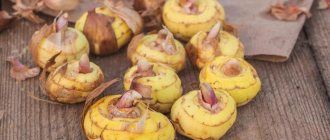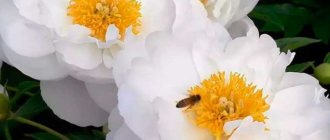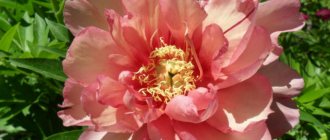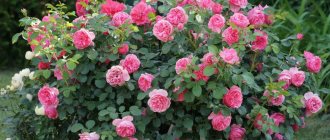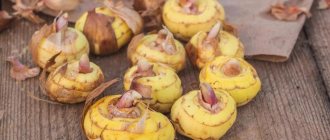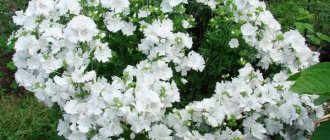Many summer residents either already grow or are just planning to plant peonies on their plots. These luxurious flowers are valued not only for their beauty, but also for their unpretentiousness and rare durability. Therefore, we decided to introduce readers to the rules for propagating these plants and planting them in open ground.
Lush, abundantly flowering bushes serve as a spectacular decoration for summer cottages and garden plots (photo by the author)
Varieties of garden peonies
The culture has been known since ancient times. It was grown in the gardens of ancient Greece and Rome. Doctors of that time used the root of the plant to prepare healing infusions. Chinese and Japanese breeders have been working for two millennia to create uniquely beautiful ornamental flower varieties.
The first peonies came to the territory of our country from Japan and China, but the culture became seriously widespread only in the 19th century, when English, French and Dutch specialists began breeding it. Today, domestic gardeners cultivate more than 1,000 varieties of these flowers, most of them of foreign origin. About 150 varieties and hybrids are registered in the State Register of Breeding Achievements of the Russian Federation.
A wide range allows you to choose varieties with different colors, degrees of terry, size and strength of flower aroma
In floriculture, classifications are adopted based on information about the origin of plants and their life forms. In accordance with it, three groups are distinguished:
| Plant shape | Botanical features | Varieties |
| Herbaceous | Unpretentious, frost-resistant plants with herbaceous stems that die off after the growing season. The flowers are large, simple, double and semi-double, of a wide variety of shapes and colors. In one place, a bush can live up to 15-20 years. Flowering begins in the second year after planting | Species (“Medicinal”, “Tonkolistny”, “Maryin Root”, etc. and their cultivars), varieties and hybrids of “Molochnotsvetkovy” |
| Tree-like | Shrubs or subshrubs with woody shoots up to 1-1.5 m high. Leaves are strongly dissected, often with a contrasting border. Flowers are double and semi-double. The petals range in color from white to pink, crimson or lilac with a dark spot at the base. Winter hardiness is average. They begin flowering late - in the 5th-6th year. They can grow in one place for 50 years or more. | Chinese-European and Japanese varieties, as well as hybrid forms obtained from crossing them with some species (botanical) varieties. In total, about 500 cultivars are known |
| Intersectional (Itoh hybrids) | Winter-hardy, disease-resistant spreading subshrubs up to 90 cm high with above-ground stems that completely die off in the winter. Foliage and flowers are similar to tree forms. Many varieties have yellow petals, which are rarely found in peonies of other groups. Flowering begins in the 3-4th year after planting. Lifespan in one place is up to 20-25 years | They were first obtained by Japanese specialist Toichi Ito (in 1948) by crossing tree-like and milk-flowering varieties. The number of forms currently existing is unknown. Not yet represented in the State Register of the Russian Federation |
Itoh hybrids are highly valued for their increased hardiness and the unusual yellow color characteristic of many of them.
In the time of our grandmothers, herbaceous peonies could be found in almost every garden. Despite the short (about 2-3 weeks) flowering period, gardeners liked the plants for their decorative effect, durability and ease of care. In recent decades, tree-like varieties began to appear on the plots, and then Ito hybrids, the latter becoming even more popular due to their winter hardiness and the huge variety of flower colors. Planting peonies is not considered difficult, but some nuances still exist for plants belonging to different groups.
The most beautiful varieties
In the garden landscape, park and universal varieties of peonies with low-growing bushes, strong stems, small and brightly colored beautifully shaped flowers are usually used.
Most often in garden plantings you can find the following varieties: Elizabeth Foster, Burma Ruby, Burgundy, Bravura Supreme, Marie Brand, Livingston, Ellis Harding, Mosero Choice, Nick Shaylor, Karina, Talisman and others.
By combining early and late flowering peonies in planting, you can create bright accents in the garden for several months. By removing the side buds and leaving the apical buds, abundant and longer flowering of peonies is achieved.
Peonies in delicate and light colors will always be in place in a flower bed or lawn
The spectacular shape of the petals of some varieties of peonies looks exotic
White peonies - a striking decoration for the lawn
Varieties of peonies by color:
- Burgundy: Reward, Red Ensigne, Red Dandy, Red Charm, Red Comet, Sable, Sward Dance.
- Reds: Red Red Rose, Sunshine, Sky Queen, Torch Song, Felix Crousse.
- Raspberry: Red Monarch, Red Romance, Rubra Triumhans, Rosedale, Thomas Vaar.
- Pink: Reine Hortense, Ruth Cobbs, Rubens, Rose Noble, Roselette, Sarah Bernhardt, Solange, Stephania, Celebration, Suzette, Fan Tan.
- White: Rosemarie Lins, Painted Dessert, Primevere, Solfatare, Susanne Braun, Festiva Maxima, Frances Willard, Advance.
- Yellow: Prairie Moon, White Sands.
Yellow peony will be an extravagant decoration for any flower bed
Cream petals with burgundy splashes - an unusual color scheme for a peony
Delicate pink peonies with a sophisticated shape look very noble
Reproduction methods
The crop can be propagated both vegetatively and by seeds. The last method is considered the least reliable, since in some varieties the seeds do not ripen at all, while in others they have very low germination. Various procedures (pre-sowing treatment with chemicals, stratification, scarification, etc.) help, but not much. Growing peony from seeds is not a difficult task, but it requires a lot of patience: material collected and sown in the fall, as a rule, does not sprout next spring, but after 1-2 years. In addition, the descendants of hybrid varieties do not inherit the properties of their “parents”. Another disadvantage is the fact that seedlings begin to bloom a year or two later than seedlings obtained by vegetative methods.
Peony seedling grown at home and ready for transplanting into open ground (photo by the author)
Of course, this does not stop flower growers. The method is attractive because it allows you to obtain new specimens of rare varieties that owners are afraid of “ruining” by digging and dividing. Note that their fears are not unfounded: the culture, in principle, does not tolerate stress well and “does not like” transplants.
The method of propagation by stem cuttings is considered a little more effective . To implement it, they usually choose stems growing in the middle of the bush. They are cut right at the ground and divided into pieces with two internodes, which are then rooted in a nutrient substrate under a mini-greenhouse. For the winter, the place where the seedlings are grown is covered with a thick layer of mulch, and next spring the young plants are transplanted to a permanent place.
Sometimes the crop is propagated by vertical layering : in the spring, the soil is raked away from the underground buds of renewal and a container without a bottom filled with a nutrient substrate is placed above the rhizome in order to stimulate the growth of a group of roots under each bud. If this is successful, independent seedlings are separated from the rhizome. Both methods are not suitable for all varieties (for example, Ito hybrids cannot be propagated this way). In addition, they are not very effective and quite labor-intensive.
The main method of vegetative propagation of a crop is dividing the bush
The most common propagation of peonies is by divisions , which are obtained by digging up the rhizome with roots and dividing it into parts. For a bush to grow from a cutting, it does not have to have a large number of buds. It is much more important that the buds are provided with normal nutrition, and for this they need thick, well-formed storage roots. Experienced flower growers note that in the first season after transplantation, only 1-3 buds usually “wake up”, but this does not prevent the plant from developing. Peonies growing in their own area are best divided at the end of summer. Bushes under 5 years old are not suitable for such propagation. It is most difficult to divide plants belonging to the group of Ito hybrids, since their renewal buds are often formed not only on the underground parts of the stems, but also on the above-ground lignified shoots. When obtaining cuttings from herbaceous varieties, problems usually do not arise.
Post-planting care
The first season after planting is very important for the normal development of the crop. She should survive the winter normally. To prevent freezing, it is better to cover it in winter. Spring-summer care involves timely watering. It is better to postpone fertilizing until next year. What is put into the planting hole is enough for the plant for the first year of life.
When the peonies bloom after planting depends on the time of transplantation and the variety. Some seedlings planted in spring try to bloom in the summer, and all autumn ones produce buds in the spring. Since the main task of a young bush is to gain root mass, it is better to postpone flowering. All buds are cut off, leaving one or two, no more. This is enough to look at a new variety and not destroy the bush.
Planting times and material selection
Ideas about the timing of planting peonies are closely related to the peculiarities of the formation of the root system of these plants. All varieties of crops have two types of roots:
| Roots | Characteristic | Functions and features of growth |
| Stockers | Thick, perennial | They are formed on the underground part of the stems during the accumulation of nutrients. They are the ones who “feed” the buds that awaken in the spring, which are laid at the base of the shoots |
| Subordinate clauses | Thin | They grow during the growing season and die off in the fall. Many thin suction processes are formed on them, which perform the main “work” of extracting nutrients and water from the soil. Small suction roots are formed in the peony bush in two “waves”: one occurs in April-May, and the other in August-September |
It is very important to plant cuttings at those moments when the active growth of thin roots stops, since their damage negatively affects the process of rooting, growth and flowering of the plant. In the period before the first “wave” of formation of suction roots begins, it is too cold in many regions of our country. Therefore, it is believed that it is most correct to plant peonies in open ground in the first half of August.
High-quality seedlings have a well-developed root system with a large number of thin adventitious roots
Unfortunately, most sellers of planting material do not take these features of peonies into account when they start selling cuttings and seedlings in early spring. Buyers of such products face the difficult task of selecting material and preserving it until planting. In this case, it makes sense to listen to the following tips:
- If possible, it is better to purchase seedlings with a closed root system. They can be transferred without unnecessary hassle and very early (as soon as the soil thaws) into a prepared planting hole. Of course, we are talking about plants that are rooted in a pot, and not just placed there immediately before sale, which is often done by unscrupulous sellers. For autumn planting, seedlings with ZKS are less suitable. The fact is that at the end of summer they often sell specimens that they did not have time to sell in the spring and were kept in cramped containers all season. Such bushes suffer from defects in the development of the root system and are sick for a long time after planting in the ground.
- Delenki, which are sold without a clod of earth, must be carefully inspected for damage and rot. You should not buy rhizomes with already sprouted buds (especially those with long, leafy stems). They may not take root at all.
- A “correct” division has several renewal buds and well-formed storage roots 18-20 mm thick (each) and a total length of at least 15 cm. If the roots are thicker (30-40 mm), they are already too “mature” and there are no the right amount of nutrients.
- Material purchased too early (in February-March) can be stored in the refrigerator directly in the packaging or sprinkled with loose soil. It is not recommended to plant such specimens in pots, since upon subsequent replanting to a permanent place, many of them die.
- If the purchased division has remnants of stems, they need to be cut to the base of the root collars. Immediately dust the sections with ash and dry them. Roots that are too long must be shortened to stimulate adventitious regrowth.
- When stored for a long time without soil, the rhizomes sometimes look wilted. It is recommended to place such material several days before planting in clean sand, lightly spilled with a weak solution of potassium permanganate.
Overwintered cuttings planted in late summer - early autumn grow faster and are able to bloom in the first season
For successful spring rooting of peonies, the soil must be cool. In central Russia, this period ends approximately at the beginning of the third ten days of April. You can try to save the roots of plants that had to be planted later from overheating by covering the planting site with light non-woven material for 2-3 weeks.
With autumn (late summer) planting, most of the problems described do not occur. During the summer, it is easier to choose a place for new bushes and prepare it properly. Therefore, plants planted in summer-autumn usually take root well. In addition, cuttings that have overwintered in a permanent place experience less stress and have time to “rest,” which allows them to produce flowering shoots in the first season, ahead of their spring “brothers” by one, and sometimes even two years.
Landing rules and consequences of mistakes
Peonies are frost-resistant and unpretentious plants. They develop and bloom well even in regions with harsh climates. The crop is also not too demanding on the composition of the soil, but it works best on light, loose soils that have a neutral or slightly alkaline reaction. When placing on a site, you need to take into account that the bushes grow strongly and “do not tolerate” large and powerful “neighbors”. The crop is photophilous: growing in dense shade leads to “fattening” of the green mass with weak flowering.
When planting several peonies, it is necessary to place them at a distance of 120-150 cm from each other.
The main mistakes when growing peonies are related to ignoring their biological characteristics. In very early spring, long before the soil dries out, these plants begin to grow suction roots. When soaked for longer than 4-6 days, the root system begins to “suffocate” and rot, and the bushes may wither. Therefore, it is very important to plant peonies so that all their roots are located above the groundwater level. In addition, it is undesirable to place bushes next to the walls of buildings, where rain and melt moisture accumulates.
The shape of the planting hole must correspond not only to the size, but also to the configuration of the division. The pieces into which the rhizome is cut are rarely symmetrical. As a rule, the storage stems of the cutting stick out to the side, and all the buds “look” to one side, which does not interfere with the development of the bush. Therefore, for a long rhizome it is not necessary to dig too deep a hole. It can be planted obliquely or almost horizontally.
Bushes placed in open, well-lit areas demonstrate abundant flowering.
The plant must be given the opportunity to eat properly. To do this, you need to take into account that all the suction roots of the peony grow below the storage roots (in fact, down from the planted section). There is one more important nuance: renewal buds are very delicate. They rot easily and therefore should not come into contact with active organic matter.
Recommendations that should be followed step by step when planting a peony are based on knowledge of these features :
- We choose a well-lit place and clear it of weeds.
- We prepare a planting hole with a depth of at least 60 cm (we select the horizontal dimensions in accordance with the parameters of the cutting or earthen ball of the seedling).
- We lay a layer of drainage on the bottom (the thickness should depend on the density of the soil).
- We fill the lower part of the hole with fertile soil with the addition of humus or rotted manure (about 25% of the volume), 1-2 cups of deoxidizer (ash or dolomite flour) and 1-2 cups of double superphosphate.
- We lay the division with the buds up and cover it with light sandy soil without nutritional supplements so that the renewal buds are no more than 3-5 cm below the surface of the earth.
A slight recess of the buds is especially important for herbaceous peonies. If the buds are much lower, the beginning of flowering of the bush is delayed for several years. For tree-like and hybrid forms, this condition is less important.
The buds are often used for cutting - they gradually open and remain fresh for a long time in a vase with water.
Planting peonies in open ground and caring for them is not very difficult. With a competent approach to this matter, the owner of the site receives a wonderful garden decoration that will delight him for decades.
Tips for flower growers
To summarize, we can give the following tips that will be useful to gardeners growing peonies:
- When planting peonies in lowlands, it is recommended to erect small elevated ridges or hills on which the planting site will be located.
- In some cases, especially when located in close proximity to groundwater, the organization of an additional drainage layer is required. For this reason, the planting hole is deepened by another 15–20 cm, after which broken bricks, coarse sand or gravel are poured into it.
- If you practice growing peonies in large quantities, you can dig not planting holes, but entire trenches. The rules for preparing them and planting bushes remain the same, but this will greatly simplify the process.


